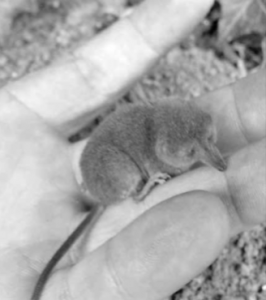Shrewd Ninjas Infiltrate the ASCCA
Names such as Masked, Vagrant, Dusky, Pygmy and Saddleback might conjure up images of a ragtag bunch of outlaws or ninjas; however, in this case, we are referring to some of the Alberta species names of the smallest and often overlooked mammals in the world, shrews. This fascinating Soricidae family is thought to be one of the closest living relatives to the placental mammals that roamed with the dinosaurs. Welcome to life in the fast lane.
Shrews are everywhere and eating everything most of their waking hours, yet why can’t we see these fascinating little beasts? Perhaps it is their size; the pygmy shrew is the weight of a penny (remember those?) and holds Canada’s record for smallest mammal at 5.5-6.1 cm in length.
The Common Water Shrew is Alberta’s largest shrew reaching up to a whopping 20 grams and they still manage to run on water with their specialized hairy feet. Although mostly they are diving into the water to catch prey. Or maybe th ereason we can’t see them is their lightning fast reflexes; scientists have recorded shrews making 12 movements per second! In comparison, the human eye contains our fastest muscles and usually only moves at a rate of 3 movements per second.

Their diminutive size should not diminish your respect, as being tiny pushes them to the extremes of survival. Due to a greater surface to volume ratio of their bodies, they need to generate heat with the food they eat at an incredibly fast rate. Eating is so important they don’t even have time to grow milk teeth in their lives. Some shrew species need to eat three times their own bodyweight in one day to keep up with their metabolism. For comparison, if a 23 kg child tried this, they would have to eat 600 hamburgers a day. In order to do this, shrews have adapted to eat lots of overlooked food sources such as ants and mites. Their diets can be mighty in other ways too, as the shrew’s ferocity (and in some species venom) allows them to take bigger prey like mice and even snakes. They also share bats’ ability to use echolocation to find prey.
A constant need for food means that winter is a harsh time for these non-hibernators. If they do not consume the proper amount hourly, they will freeze to death. This sadly means that spring hikes are the best time to reveal these seldom seen ninjas as you might come across deceased ones on the trail. Do not be fooled into thinking it is just another rodent. If you are lucky enough to see one (hopefully alive) the most distinguishing feature is their narrow little snouts. They also have five toes on each foot, unlike rodents. Only the Masked and Pygmy shrew have been recorded on the ASCCA so far, but most likely only due to their stealth. Please send photos or report any of your shrew sightings to info@ crossconservation.org . Spread the love for the little shrew hearts that beat over 1000 beats/minute.
By Laura Griffin
During the COVID-19 pandemic, the ASCCA is open for families to visit to enjoy nature. To make the area more accessible, we are suspending our parking fee. Our building and all washrooms, however, will be closed to the public. We recommend keeping a distance of two meters from other hikers. Dogs, bikes and skies are not permitted on the ASCCA. We encourage you to share happy nature moments on our Facebook and Twitter pages (@ASCConservation) to lift the community spirit. We are also still accepting registrations for Nature Safari Day Camps: 403-931-2042.


























